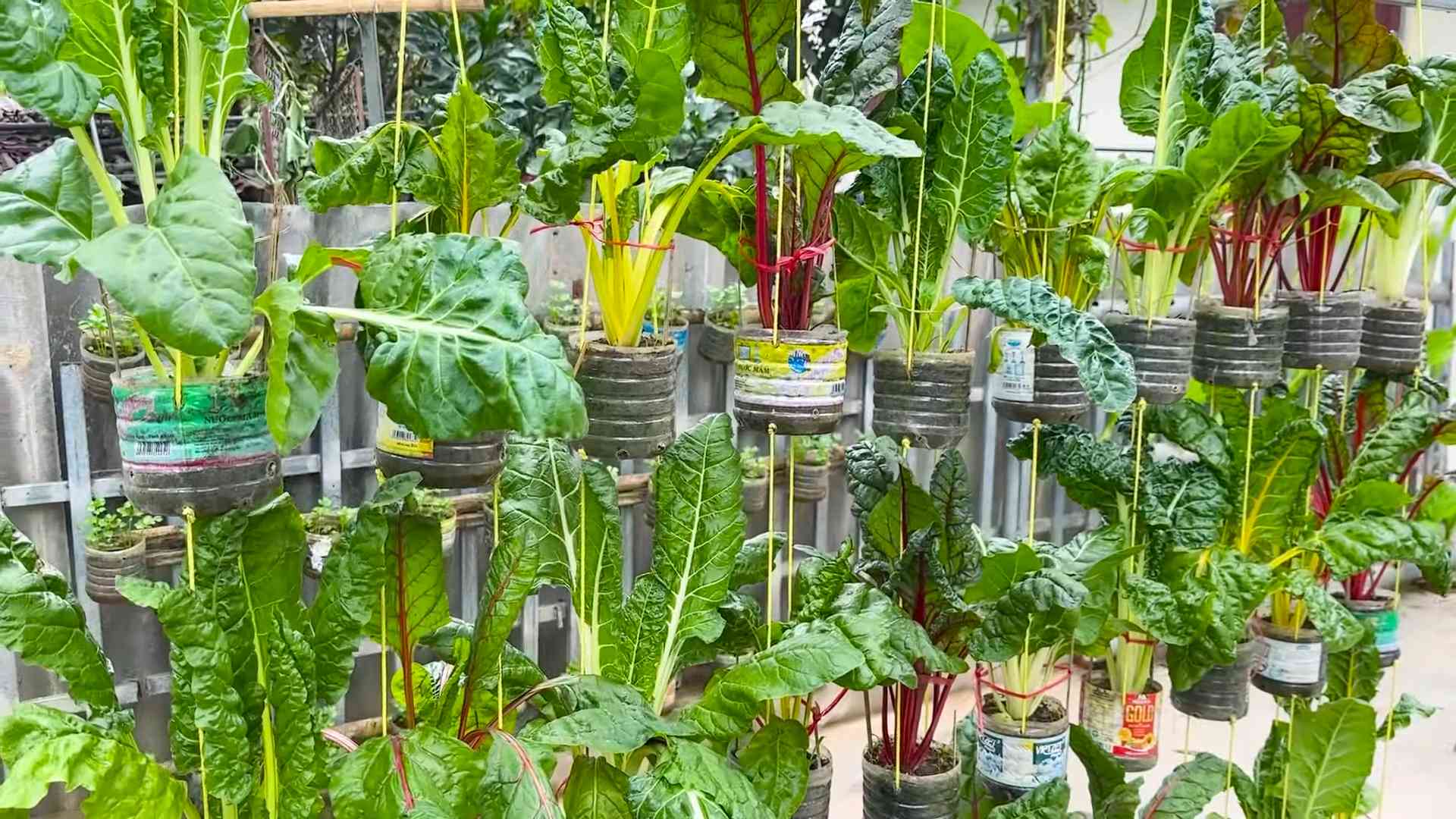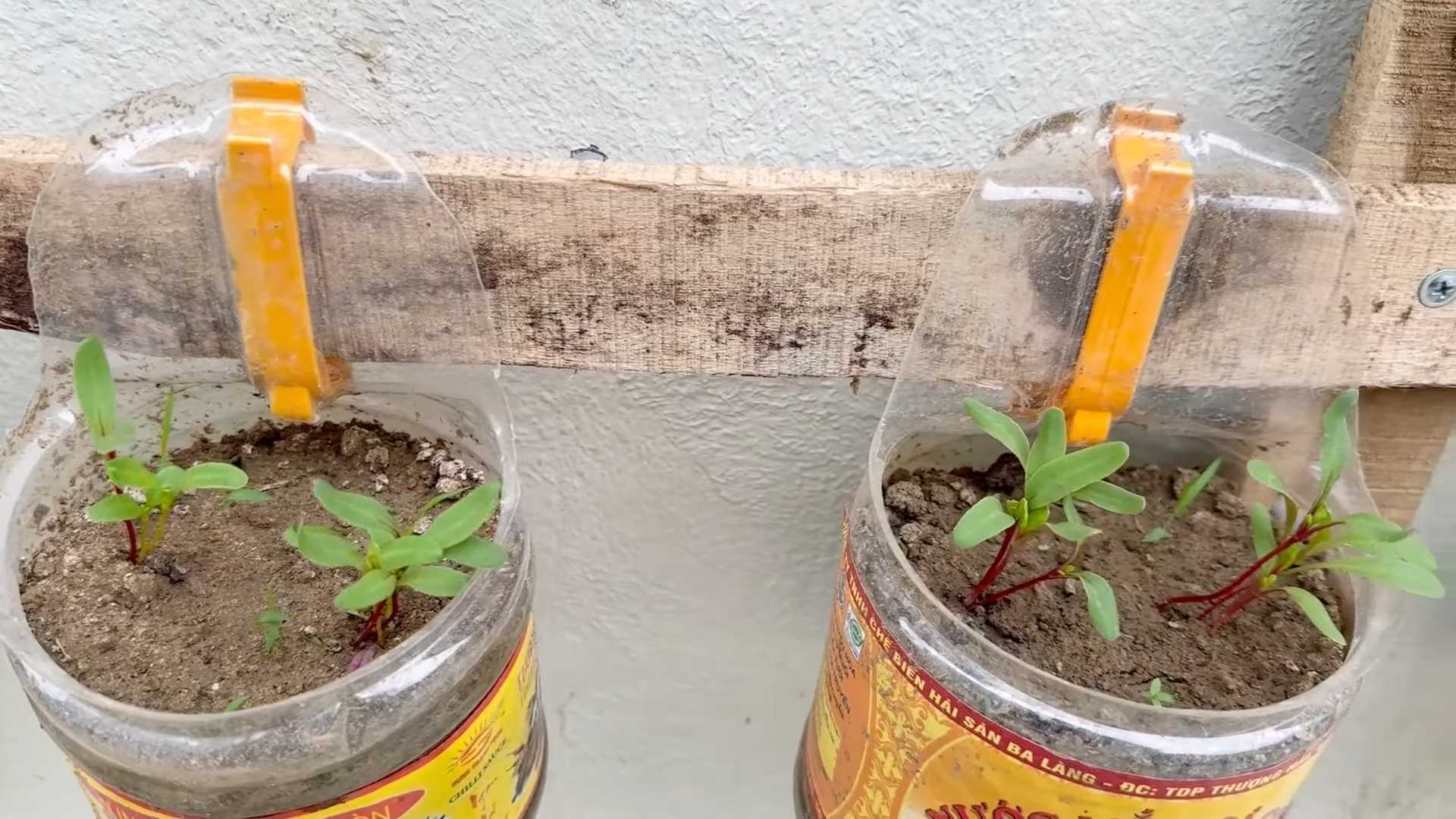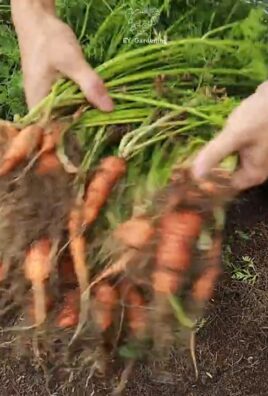Grow Rainbow Chard Easily and add a burst of vibrant color and nutrition to your garden and plate! Have you ever dreamed of a garden that’s not only productive but also a feast for the eyes? Imagine rows of dazzling, jewel-toned leaves swaying gently in the breeze. That’s the magic of Rainbow Chard, and I’m here to tell you that cultivating this beauty is easier than you might think!
For centuries, chard has been a staple in Mediterranean cuisine, prized for its versatility and health benefits. Its vibrant colors, however, are a more recent development, making Rainbow Chard a modern marvel that blends tradition with visual appeal. But beyond its aesthetic charm, Rainbow Chard is packed with vitamins and minerals, making it a nutritional powerhouse that can elevate your meals.
So, why do you need these DIY tricks and hacks for growing Rainbow Chard? Well, while chard is relatively low-maintenance, a few clever strategies can significantly boost your yield and ensure your plants thrive. I’ll guide you through simple yet effective techniques, from seed to harvest, that will help you grow Rainbow Chard easily, even if you’re a beginner gardener. Get ready to transform your garden into a colorful and bountiful oasis!

Grow Rainbow Chard Easily: A Colorful Addition to Your Garden (and Plate!)
Hey there, fellow garden enthusiasts! I’m so excited to share my tried-and-true method for growing vibrant and delicious rainbow chard. It’s honestly one of the easiest and most rewarding vegetables to cultivate, adding a splash of color to your garden and a boost of nutrients to your meals. Trust me, even if you’re a beginner, you can totally nail this!
Why Rainbow Chard?
Before we dive in, let’s talk about why rainbow chard is so awesome:
* It’s Beautiful: Seriously, those brightly colored stems (red, yellow, orange, pink, white) are a feast for the eyes.
* It’s Nutritious: Packed with vitamins A, C, and K, as well as fiber and antioxidants, it’s a superfood powerhouse.
* It’s Versatile: You can eat the leaves raw in salads, saut茅 them, steam them, add them to soups, or even use them in smoothies.
* It’s Easy to Grow: Seriously, it’s pretty forgiving and can tolerate a range of conditions.
* It’s Productive: You can harvest leaves continuously throughout the growing season.
Getting Started: What You’ll Need
Okay, let’s gather our supplies. Here’s what you’ll need to grow your own rainbow chard:
* Rainbow Chard Seeds: You can find these at most garden centers or online. Make sure to choose a reputable brand for good germination rates.
* Potting Mix (for starting seeds indoors) or Garden Soil: If you’re starting seeds indoors, use a good quality seed starting mix. If you’re planting directly in the garden, make sure your soil is well-draining and amended with compost.
* Seed Starting Trays or Small Pots: If you’re starting seeds indoors.
* Watering Can or Hose: For watering your plants.
* Fertilizer (optional): A balanced fertilizer can help boost growth, but it’s not essential.
* Gardening Gloves: To keep your hands clean.
* Trowel or Garden Fork: For planting and amending the soil.
* Mulch (optional): To help retain moisture and suppress weeds.
Phase 1: Starting Seeds (Indoors or Outdoors)
You have two options for starting your rainbow chard: indoors or directly in the garden. Starting indoors gives you a head start, especially if you live in a colder climate.
Starting Seeds Indoors
1. Prepare Your Seed Starting Trays: Fill your seed starting trays or small pots with seed starting mix. Gently press down the soil to remove any air pockets.
2. Sow the Seeds: Make a small indentation (about 1/4 inch deep) in the soil. Place 2-3 seeds in each indentation. Cover the seeds with a thin layer of soil.
3. Water Gently: Water the soil gently using a watering can or spray bottle. You want to moisten the soil without disturbing the seeds.
4. Provide Warmth and Light: Place the trays in a warm location (around 65-75掳F) and provide plenty of light. A sunny windowsill or a grow light works well.
5. Keep the Soil Moist: Check the soil regularly and water when the top inch feels dry. Don’t overwater, as this can lead to damping off (a fungal disease that kills seedlings).
6. Thin the Seedlings: Once the seedlings have their first true leaves (the second set of leaves), thin them to one seedling per cell or pot. Choose the strongest seedling and snip off the others at the soil line.
7. Harden Off the Seedlings: Before transplanting the seedlings outdoors, you need to “harden them off.” This means gradually exposing them to outdoor conditions over a period of 7-10 days. Start by placing them in a sheltered spot outdoors for a few hours each day, gradually increasing the amount of time they spend outside.
Starting Seeds Outdoors (Direct Sowing)
1. Prepare the Soil: Choose a sunny spot in your garden with well-draining soil. Amend the soil with compost to improve its fertility and drainage.
2. Sow the Seeds: Sow the seeds directly into the soil, about 1/2 inch deep and 1 inch apart.
3. Water Gently: Water the soil gently using a watering can or hose.
4. Keep the Soil Moist: Keep the soil consistently moist until the seeds germinate.
5. Thin the Seedlings: Once the seedlings emerge, thin them to 6-12 inches apart.
Phase 2: Transplanting (If Starting Indoors)
Once your seedlings have been hardened off and the danger of frost has passed, it’s time to transplant them into the garden.
1. Choose a Sunny Location: Rainbow chard prefers full sun (at least 6 hours of sunlight per day), but it can tolerate some partial shade.
2. Prepare the Soil: Make sure the soil is well-draining and amended with compost.
3. Dig Holes: Dig holes that are slightly larger than the root balls of your seedlings. Space the holes 6-12 inches apart.
4. Gently Remove the Seedlings: Carefully remove the seedlings from their trays or pots, being careful not to damage the roots.
5. Place the Seedlings in the Holes: Place the seedlings in the holes and gently backfill with soil.
6. Water Thoroughly: Water the seedlings thoroughly after planting.
Phase 3: Caring for Your Rainbow Chard
Now that your rainbow chard is planted, it’s time to provide it with the care it needs to thrive.
1. Water Regularly: Rainbow chard needs consistent moisture, especially during hot, dry weather. Water deeply whenever the top inch of soil feels dry.
2. Fertilize (Optional): If you want to give your rainbow chard a boost, you can fertilize it every few weeks with a balanced fertilizer. Follow the instructions on the fertilizer package.
3. Weed Regularly: Keep the area around your rainbow chard free of weeds. Weeds can compete with your plants for nutrients and water.
4. Mulch (Optional): Applying a layer of mulch around your rainbow chard can help retain moisture, suppress weeds, and regulate soil temperature.
5. Watch for Pests and Diseases: Rainbow chard is generally pest-resistant, but it can be susceptible to aphids, slugs, and snails. If you notice any pests, you can try spraying them with insecticidal soap or hand-picking them off the plants. Fungal diseases can also be a problem, especially in humid conditions. Make sure to provide good air circulation around your plants and avoid overwatering.
Phase 4: Harvesting Your Rainbow Chard
The best part! You can start harvesting your rainbow chard leaves once they are about 6 inches long.
1. Harvest Outer Leaves: Harvest the outer leaves first, leaving the inner leaves to continue growing.
2. Cut at the Base: Cut the leaves at the base of the plant, using a sharp knife or scissors.
3. Harvest Regularly: Harvesting regularly will encourage the plant to produce more leaves.
4. Enjoy Your Harvest: Wash the leaves thoroughly and enjoy them in salads, saut茅ed dishes, soups, or smoothies.
Tips for Success
Here are a few extra tips to help you grow the best rainbow chard ever:
* Choose the Right Variety: There are several different varieties of rainbow chard available, so choose one that is well-suited to your climate.
* Provide Good Drainage: Rainbow chard doesn’t like to sit in soggy soil, so make sure your soil is well-draining.
* Protect from Frost: Rainbow chard can tolerate light frost, but it’s best to protect it from hard freezes. You can cover the plants with a blanket or row cover.
* Succession Planting: To ensure a continuous harvest, sow seeds every few weeks throughout the growing season.
* Enjoy the Stems Too!: Don’t throw away the stems! They are delicious and nutritious. You can chop them up and saut茅 them or add them to soups.
Troubleshooting
Even with the best care, you might encounter a few problems along the way. Here are some common issues and how to address them:
* Yellowing Leaves: This could be a sign of nutrient deficiency. Try fertilizing with a balanced fertilizer.
* Holes in Leaves: This could be caused by slugs or snails. Try using slug bait or hand-picking them off the plants.
* Wilting Leaves: This could be a sign of underwatering. Make sure to water your plants regularly, especially during hot,

Conclusion
So, there you have it! Growing rainbow chard from seed is not only surprisingly simple, but it’s also incredibly rewarding. Imagine stepping out into your garden and harvesting vibrant, jewel-toned leaves for your salads, stir-fries, or even as a beautiful garnish. Forget those wilted, overpriced bunches at the grocery store. With a little patience and these easy-to-follow steps, you can have a constant supply of fresh, organic rainbow chard right at your fingertips.
This DIY trick is a must-try for several reasons. First, it’s significantly more cost-effective than buying rainbow chard regularly. Second, you have complete control over the growing process, ensuring that your chard is free from harmful pesticides and chemicals. Third, and perhaps most importantly, it’s an incredibly satisfying experience to nurture a plant from seed to harvest. There’s a certain magic in watching those tiny seeds sprout and transform into a colorful, edible masterpiece.
Don’t be afraid to experiment with different varieties of rainbow chard. Some boast brighter reds and oranges, while others lean towards yellows and purples. You can also try companion planting. Rainbow chard thrives alongside other vegetables like carrots, onions, and garlic, which can help deter pests and improve soil health. Consider succession planting 鈥?sowing new seeds every few weeks 鈥?to ensure a continuous harvest throughout the growing season. If you’re short on space, rainbow chard also grows beautifully in containers, making it perfect for balconies or patios. Just be sure to choose a pot that’s large enough to accommodate its root system.
Ready to transform your garden and your plate? We wholeheartedly encourage you to give this DIY trick a try. It’s a fantastic way to connect with nature, save money, and enjoy the freshest, most flavorful rainbow chard imaginable. And remember, gardening is a journey, not a destination. Don’t be discouraged if you encounter a few bumps along the way. Every mistake is a learning opportunity.
We’re confident that you’ll be amazed at how easy and enjoyable it is to grow your own rainbow chard. Once you’ve harvested your first batch, be sure to share your experience with us! We’d love to see photos of your vibrant chard and hear about your favorite ways to prepare it. Use the hashtag #RainbowChardDIY on social media so we can all celebrate your gardening success together. Happy growing!
Frequently Asked Questions (FAQ)
What is the best time of year to plant rainbow chard seeds?
Rainbow chard is a cool-season crop, so the best time to plant seeds is in early spring or late summer. For a spring crop, start seeds indoors 4-6 weeks before the last expected frost. For a fall crop, sow seeds directly into the garden in late summer, about 6-8 weeks before the first expected frost. This allows the plants to mature before the weather gets too cold. In warmer climates, you can often grow rainbow chard throughout the winter.
How much sunlight does rainbow chard need?
Rainbow chard thrives in full sun, which means at least 6 hours of direct sunlight per day. However, in hotter climates, it can benefit from some afternoon shade to prevent the leaves from scorching. If you’re growing rainbow chard indoors, make sure to provide it with plenty of light, either through a sunny window or with grow lights. Insufficient sunlight can result in leggy plants with weak stems.
What kind of soil is best for growing rainbow chard?
Rainbow chard prefers well-drained, fertile soil that is rich in organic matter. Before planting, amend the soil with compost or well-rotted manure to improve its fertility and drainage. The ideal soil pH for rainbow chard is between 6.0 and 7.0. You can test your soil pH with a simple soil testing kit available at most garden centers. If your soil is too acidic, you can add lime to raise the pH.
How often should I water rainbow chard?
Rainbow chard needs consistent moisture to thrive. Water deeply and regularly, especially during dry periods. Aim to keep the soil consistently moist but not waterlogged. Overwatering can lead to root rot, so make sure the soil is well-draining. A good rule of thumb is to water when the top inch of soil feels dry to the touch. Mulching around the plants can help retain moisture and suppress weeds.
How do I harvest rainbow chard?
You can start harvesting rainbow chard leaves when they are about 6 inches long. Harvest the outer leaves first, leaving the inner leaves to continue growing. This cut-and-come-again method allows you to harvest rainbow chard continuously throughout the growing season. Use a sharp knife or scissors to cut the leaves near the base of the plant. Avoid pulling the leaves, as this can damage the plant.
What are some common pests and diseases that affect rainbow chard?
Rainbow chard is generally a hardy plant, but it can be susceptible to certain pests and diseases. Common pests include aphids, flea beetles, and leaf miners. You can control these pests with insecticidal soap or neem oil. Diseases that can affect rainbow chard include leaf spot and downy mildew. To prevent these diseases, ensure good air circulation around the plants and avoid overhead watering. Remove any infected leaves promptly to prevent the disease from spreading.
Can I eat the stems of rainbow chard?
Yes, the stems of rainbow chard are perfectly edible and delicious! They have a slightly different texture and flavor than the leaves, but they are equally nutritious. You can cook the stems in the same way you would cook celery or asparagus. Try saut茅ing them with garlic and olive oil, or adding them to soups and stews. The stems can also be pickled or used in salads.
How do I store rainbow chard after harvesting?
To store rainbow chard after harvesting, wash the leaves thoroughly and pat them dry. Wrap the leaves in a damp paper towel and store them in a plastic bag in the refrigerator. Rainbow chard can be stored in the refrigerator for up to a week. For longer storage, you can blanch the leaves and freeze them.
Can I grow rainbow chard in containers?
Yes, rainbow chard grows well in containers. Choose a pot that is at least 12 inches in diameter and 12 inches deep to allow enough room for the roots to grow. Use a well-draining potting mix and make sure the container has drainage holes. Place the container in a sunny location and water regularly. Container-grown rainbow chard may need to be fertilized more frequently than plants grown in the ground.
Is rainbow chard nutritious?
Absolutely! Rainbow chard is packed with vitamins, minerals, and antioxidants. It’s an excellent source of vitamins A, C, and K, as well as magnesium, potassium, and iron. Rainbow chard is also a good source of fiber, which is important for digestive health. Adding rainbow chard to your diet can help boost your immune system, improve bone health, and protect against chronic diseases.




Leave a Comment